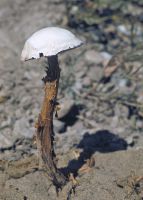Habitat: Dry woodland, scrub, and desert
Conservation Status: Not of concern
Edibility: not edible
not edible
Podaxis pistillaris grows in similar arid places, but has a shaggy, elongated cap or head. Fruiting body: initially underground and completely enclosed by a membrane (outer peridium) which ruptures around its periphery, the stalk then bursting through and rapidly elongating. Mature fruiting body composed of a spore case (the inner peridium) mounted on a long stalk, with the ruptured outer peridium leaving a volva at base of stalk and sometimes a volval path on top of the spore case. Spore Case: 3-5 cm broad and 1-3.5 cm high, typically rounded (convex) on top, with a flat or even depressed (concave) underside that somewhat resembles a "veil"; surface smooth, pallid or whitish, soon splitting around its lower periphery so that the upper (rounded) portion falls off, thereby exposing the spore mass; lower portion remaining intact as a disc beneath the spore mass and sometimes persisting (after spore mass has dispersed) as a disclike "cap" or sliding down the stalk to form a "ring." Stalk: 10-40 cm long, 0.4-1.5 cm thick, not percurrent, equal or tapered downward (but volva-encased base may be swollen);rigid and tough or even woody, hollow, white to brownish or rusty-brown, longitudinally striate or grooved and covered with fibers that often peel or split to form fine to very coarse needlelike, ribbonlike, or shaggy scales. Volva: at base of stalk saclike, whitish or dirt-incrusted, often loose, buried in ground and soon rotting away. Spore Mass: rusty-brown and powdery when mature, adhering to everything it comes in contact with; odor sometimes unpleasant in old age.
Battarrea stevenii is sometimes considered a separate, larger species occurring in southern Europe and elsewhere, but analysis of DNA sequencing suggests it is not distinct and the two are treated here as a single species.
Sources: Roberts, Peter and Evans, Shelley. The Book of Fungi. Chicago, The University of Chicago Press, 2011. Arora, David. Mushrooms Demystified. Berkeley, Ten Speed Press, 1986.
PNW Herbaria: Specimen records of Battarrea phalloides in the Consortium of Pacific Northwest Herbaria database.
CalPhotos: Battarrea phalloides photos.





